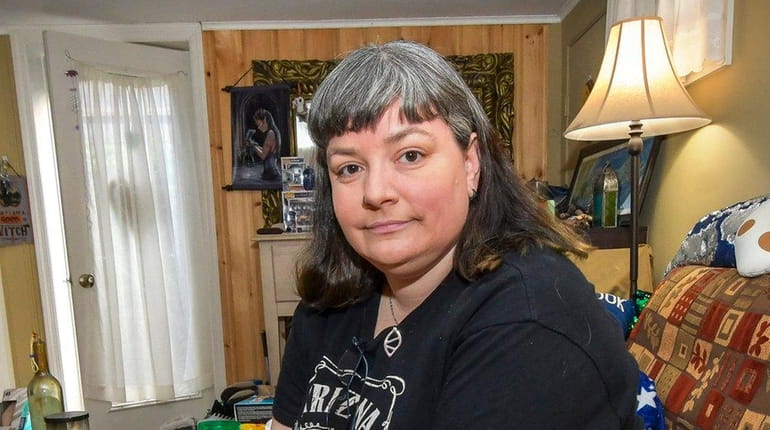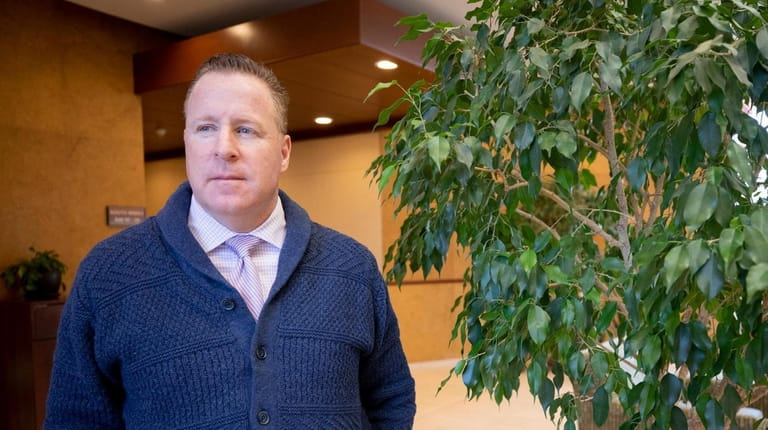Long Island millennials, parents drowning in college debt

Meri Kassmer, 38, lives alone in a basement apartment in Locust Valley. Her student loan balance is $40,000. Credit: Howard Simmons
Meri Kassmer didn't want anything fancy: a house in the suburbs, a reliable car in the driveway and the occasional family vacation.
But there's no house — only a basement apartment in Locust Valley, where she lives alone — and no vacations to speak of.
At 38, Kassmer is struggling to pay off $40,000 in student loans for a bachelor's degree in elementary education that she doesn't use anymore. She started off more than $60,000 in debt from her days at SUNY Old Westbury.
"I feel like I am swimming and can't keep my head above water and can't get air," said Kassmer, who taught preschoolers for five years before taking a higher-paying job as an emergency medical technician at a construction site. "It affects all aspects of my life."
Kassmer is far from alone.
Countless Long Island millennials, and their parents, are facing tens of thousands of dollars in college debt, according to federal data and financial experts. And their burden is made even heavier by the region's high cost of living, local economic numbers show.
Over the past 25 years, the one-two punch has made it a struggle to keep younger Long Islanders from moving away. In 1990, the number of 25- to 34-year-olds hit a peak of 430,400; by 2016, the total stood at about 327,250, and two-thirds still lived at home, census figures show.
Simultaneously, tuitions climbed — at some schools to cover slashes in public funding, at others to defray rising expenses or offer more amenities to attract more students, government and high education studies showed.
Long Island's average student loan balance stood at $32,400 in 2016, eclipsing both the state and national averages of $31,600 and $29,900, respectively, according to the latest data available from the Federal Reserve of New York.
Those five- and six-figure IOUs have many like Kassmer walking a financial tightrope without a net, forcing them to put off buying a home, a new car and even getting married and having kids, the financial experts said.
And putting life on hold can last decades. The federal government, for example, lets a borrower of $30,000 take as long as 25 years to settle the debt. For a private loan, the repayment term can vary from five to 20 years, government figures show.
"It’s just obvious that if . . . you have to pay a couple hundred a month for student loans, you have less money for other things," said Sandy Baum, an economist at the Washington-based Urban Institute who specializes in higher education finance.
Living with the folks
Borrowers nationwide are playing out their lives much like Kassmer is, surveys show.
Six out of 10 have less than $1,000 in their checking accounts because of college debt, and one in three pays more monthly on student loans than on rent, according to 7,000 borrowers surveyed last fall by Student Debt Crisis, a Manhattan-based nonprofit group that wants to make college free.
Consequently, the report said, the borrowers frequently find themselves forced to hit the brakes on marriage, children and a house.
The numbers are sobering, especially for homeownership, the survey showed.
While one in five has delayed saying "I do" and one in four is holding off on parenthood, better than half have ruled out buying a home, according to the report.
In no small part, the reduced rate of homeownership is the upshot of a doubling in the average student loan balance in the last decade, numbers show. Nationally, student debt balance per borrower climbed from $17,900 to $29,900 between 2006 and 2016. Locally, the figure jumped from $20,800 to $32,400, or nearly 56 percent, according to the Fed's New York Bank.
Separate research by economists at the Federal Reserve Board on student debt and homeownership among 24- to 32-year-olds from 2005 to 2014 shows more than 400,000 young adults across the country would have been homeowners by 2014 if they weren't carrying such big balances.
Long Island is a textbook example of the fallout.
Of every 10 millennials here, six are living with their parents or roommates, and only two own a home, according to census data analyzed by the Long Island Association, the region's largest business group.
"These are pretty unpleasant decisions," said John Rizzo, LIA's chief economist. "You could be 30-year-old and still living at home. You're stuck with this debt. It's better to stay home and live with your parents."
Those shifts in living arrangements reflect not only the bigger average student loan balance but a 20 percent decline in median salaries and a 150 percent uptick in real estate prices over the past 40 years, the analysis showed.
Jonathan Meneses is what he calls "well compensated" for his job as an IT manager, but he and his wife still delayed buying a home for three years because of college debt. Now, they have a home in East Rockaway.
"The debt has really taken away years of earnings that could have been used for buying a house earlier or put away for a rainy day," said Meneses, 29, a 2011 graduate of the New York Institute of Technology in Old Westbury.
"We try not to live beyond our means, but with the way student loans are structured, we in the end do feel trapped," he said.
Nikki Taylor Friedman has a unique perspective on young people and homebuying, being a young adult herself and a real estate agent for Douglas Elliman.
"They're not willing to put themselves further in debt," said Friedman, 23, who is based in Douglas Elliman's Huntington office. "Millennials still want to save for the American dream. They just want to pay off their debt first."
Do the math
The crisis has been deepening for more than a decade, mostly the result of cuts in education funding spurred by the 2008 recession and higher costs for colleges and universities tied to attracting students, experts said.
Steve Von Bargen of Massapequa can speak to the impact of the recession. After the stock market crashed, he and his wife had to rely heavily on loans to pay for the undergraduate degrees that they had promised their three children.
“We can’t go on vacation,” said Von Bargen, 58. “We used to buy a car every five to six years. Now our cars are a decade old.”
Then, two of the three Von Bargen kids went on to graduate school — on their own dime. All together, Von Bargen estimates the trio incurred hundreds of thousands of dollars in debt, although he declined to provide an exact figure.
Today, they all have jobs and live on their own. But that’s not the case for many of their peers, he said.
“It’s an epidemic,” he said. “You look at my street . . . everybody’s living at home.”
As the rocky economy recovered, tuitions inched up year by year for both private and public colleges and universities, numbers show.
On Long Island, for example, the average undergraduate tuition for 11 public and private colleges increased roughly 50 percent, from $14,515 in 2008-09 to $21,960 this school year, according to numbers not adjusted for inflation. Students also are responsible for room and board, as well as fees and books.
Tuition increases have helped schools both close the gap created by cuts in government subsidies and stay competitive — by paying for everything from technology upgrades and health care costs to new construction and top-notch professors.
In New York, support from Albany for the state's 64 public universities has stayed flat. And aid for the system’s two-year community colleges, including the ones in Nassau and Suffolk counties, is based on enrollment, and many have seen declines in the number of students.
Stony Brook University, for example, has seen its state funding drop from $190 million in 2008-09 to $147 million this year, said Braden Hosch, assistant vice president for Institutional Research, Planning and Effectiveness.
And despite belt-tightening at the 26,000-student university, Hosch said, “ultimately the students have been asked to make up for the gap that the state has not been able to fill.”
Still, Hosch contends that Stony Brook remains affordable. Of bachelor’s degree recipients who started as freshmen at the university, almost half graduate debt-free by patching together grants and help from family members, he said.
The amount of debt a Long Island graduate walks away with often depends on whether the school is private or public, numbers show.
Adelphi University is a private institution in Garden City. The median debt for an undergraduate degree increased almost two-thirds in a decade — from $15,518 in 2007 to $25,000 in 2017, numbers show.
Conversely, SUNY Old Westbury and the two-year Suffolk County Community College are public — and had lower median debts. SUNY Old Westbury saw its median debt increase 26 percent, from $13,500 to $17,000. SCCC graduates left $7,000 in debt, up more than 34 percent from just over $5,200.
Gail Eyl of Baldwin sent her children to private college in the late 1990s, a decision she is still paying for. Every month, the mother of four puts $550 toward her $25,000 loan balance.
The debt has forced Eyl, at 66, to postpone retirement from her career as an interior designer.
"I want to do something else," she said. "It would be nice to have that extra money every month. I haven't gone on a vacation in five years."
Pain vs. gain
So is it worth it to take on tens of thousands of dollars of debt that ultimately will take decades to pay off?
Absolutely, experts agreed.
“They’re not just throwing away their money,” said Liang Zhang, a professor of higher education at New York University. “They benefit from the investment in human capital. I think the research has consistently demonstrated that a college education matters, it pays off.”
Government statistics prove Zhang's point. In 2017, the median weekly earnings for bachelor’s degree recipients was $1,173, compared with $836 for those with an associate degree, $712 for high school graduates and $520 for high school dropouts, according to U.S. Department of Labor.
And while college graduates are waiting longer to buy a home, Zhang said, many end up buying a more expensive property because of their higher earning power.
Still, Zhang said, students need to consider the return on investment when they borrow for a college degree. Those who fail to plan properly run the risk of default, he said.
On Long Island, 9.3 percent of borrowers in 2016 were considered seriously delinquent on their student loan debt, compared with 12.1 percent statewide and 15.6 percent across the country, according to the Federal Reserve Bank of New York.

Dave Barry, shown here in his Melville office, has seen his daughter amass student loan debt as he continues to pay off his own decades-old loans. Credit: Yeong-Ung Yang
For commercial lender Dave Barry, student loans were a "necessary evil" to get his college degree so he could earn enough to support his family.
Barry, who lives in Islip, is still paying off debt that he started to amass when he was a student at Suffolk County Community College in the mid-1980s. A decade later, Barry graduated with a bachelor's degree from Hofstra University. Then, he spent 18 months at Concord Law School in Los Angeles but didn't finish.
The final bill: roughly $70,000, which Barry estimates he has pared down to about $20,000.
"It's a double-edged sword," said Barry, 54, who expects to delay his retirement from TD Bank by at least three years to pay off his student loans. "There's a sense of accomplishment that I am paying the loans down myself. But I don't see how my daughter can ever be successful in this environment."
Barry's daughter, Kaytie, is a senior at Penn State University studying broadcast journalism. Her college debt is roughly $160,000.
"It does not seem like it will never end," he said.
An earlier of this article misconstrued data from the Federal Reserve on the amount of student debt balance per borrower and student debt and homeownership.
How to repay your student loan
Whether you borrowed from the federal government or a private bank, make your monthly payment or you'll be considered delinquent — and you don't want that to happen. Delinquent loans eventually go into default, which makes the entire loan balance immediately due.
- Standard repayment: Pay a fixed amount each month until the loan is paid in full.
- Extended repayment: Pay a fixed annual or graduated amount over a period not to exceed 25 years. This means smaller payments, but you ultimately pay more in interest.
- Graduated repayment: Allows for low payments in the beginning that increase every two years up to 10 years.
- Income-based repayment: Uses a sliding scale based on income and family size to determine payment amount.
- Consider consolidating multiple loans into one monthly payment.
- Create a personalized repayment action plan with the state’s online Loan Repayment Advisor tool at www.hesc.ny.gov.
Source: New York State Higher Education Services Corp.
Kinds of loans
There are two types of student loans, federal and private.
Federal loans: The federal government makes four kinds of direct loans: subsidized, unsubsidized, ones for graduate and professional students, and ones for parents. A subsidized loan is one based on financial need and the government pays the interest while the borrower is in school. They may include benefits such as fixed interest rates and income-driven repayment plans, and they don’t come due until after the borrower graduates or leave school. Terms and conditions are set by law.
Private loans: A private organization, such as a bank, is the lender and sets the loan's terms and conditions. Interest rates can be variable or fixed. Repayment can start while the borrower is still in school.
Source: Studentaid.ed.gov

